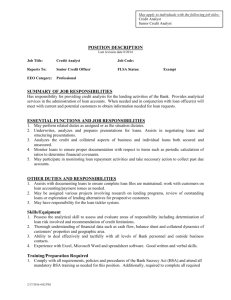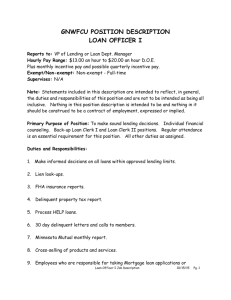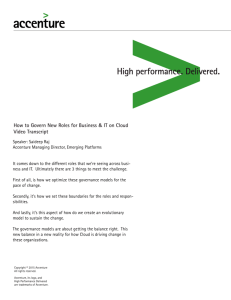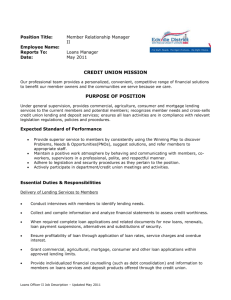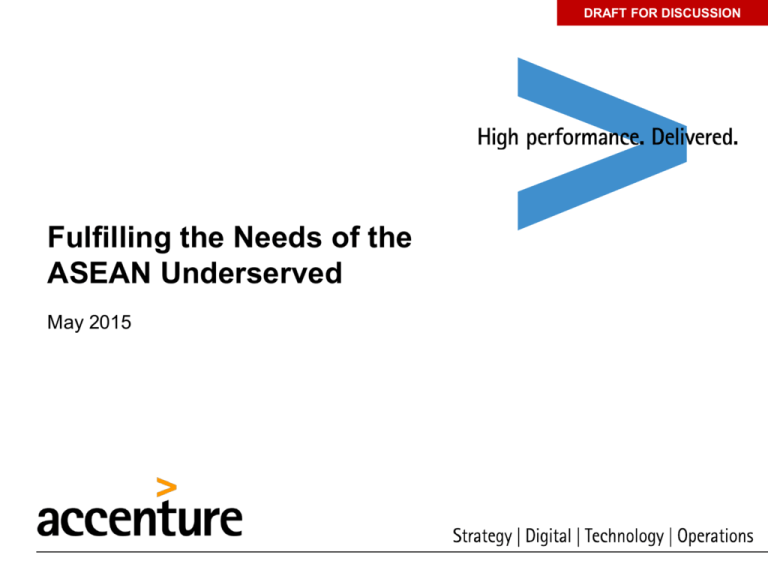
DRAFT FOR DISCUSSION
Fulfilling the Needs of the
ASEAN Underserved
May 2015
DRAFT FOR DISCUSSION
Recap of 2014 ABC Forum on ‘fueling ASEAN growth through an
integrated financial and capital market’
Financial Services Industry
Establish regional industry utilities to foster
integrated financial and capital market
• Leverage exchange infrastructure (e.g. ASEAN
trading link)
• Participant-led utilities driven by a consortium of
banks
• Lead with industry practices especially in new
domain, laying the foundation for policy and
regulation
Leverage new phenomena such as internet financial
services platforms to provide alternative funding
options that mitigate constraints
• Peer-to-peer financing
• Crowdfunding
Focus of today’s discussion
Copyright © 2015 Accenture All rights reserved.
Policy Makers
Build trust through enhanced regulatory alignment
• Move towards a common regulatory framework
(e.g. alignment and coordination of policies)
• Standardised rule making body
• Capital flow liberalisation
Creation of an ASEAN “growth" bank to support
economic development
• Foster greater financial and development
cooperation among ASEAN member states
• Provide financing for infrastructure projects
Support industry-driven initiatives
Focus on talent development and mobility
Implementation of Recommendations is in
Progress
ASEAN-5: Indonesia, Malaysia, the Philippines, Singapore and Thailand
BCLMV: Brunei, Cambodia, Laos, Myanmar, Vietnam
2
DRAFT FOR DISCUSSION
Many small and mid-sized corporates have struggled to obtain
funding through financial institutions to meet financing needs
Underserved
Corporate
Financing Needs –
Micro to MidCaps
• Today, most public
exchanges only list and
trade equities, debt and
derivatives instruments,
which do not holistically
solve many small and
medium corporate
funding needs
Very Small
Firms
possibly with no
collateral and no
track record
Medium sized
Firms
Large Firms
of known risks and
track record
some track record,
collateral available if
necessary
Initial Insider
Finance
Angel Capital
Venture Capital
Public Equity
Commercial Paper
Short Term Financial Institution
Loans
Intermediate Term Financial
Institution Loans
• Lenders have been
hesitant to extend credit
due to poor consistency
of financial/credit
reporting standards,
lack of credit ratings
and concerns of cross
border ownership rights
• Requires more
sophisticated and
innovative institutional
arrangements in order
to respond effectively to
the real needs of this
segment
Small Firms
possibly with high
growth potential but
often with limited
track record
Supply Chain Financing and Trade Finance
Mid Term Notes
Mezzanine
Fund Financing
Private
Placement
Significant unmet financing demand
Copyright © 2015 Accenture All rights reserved.
Public Debt
3
DRAFT FOR DISCUSSION
Within ASEAN, the AEC has recognized the challenges of SMEs
within the region and implemented initiatives to address them
SMEs account for more than 96% of all enterprises and 50% to 85% of
domestic employment. The contribution of SMEs to GDP is between
30% and 53% and the contribution of SMEs to exports is between 19%
and 31%.
Within the ASEAN Strategic Plan for SME
Development (2010 – 2015), 5 key goals
were identified…
Access to Finance
Access to Market and
Internationalization of SMEs
Access to Human Resource
Development
Access to Information and
Advisory Services
Access to Technology and
Innovation
Copyright © 2015 Accenture All rights reserved.
… and there has been significant
investments and initiatives to ease SME’s
access to finance and funding.
• 2008-09 - Established a common curriculum for
entrepreneurship in ASEAN
• 2010-11 - Established a comprehensive SME service
centre with regional and subregional linkages in ASEAN
Member Countries
• 2010-11 - Established an SME financial facility in each
ASEAN Member Country
• 2012-13 - Established a regional programme for the
promotion of internship scheme for staff exchanges and
visits for skills training
• 2014 -15 - Established a regional SME development
fund that would be used as a financial source for SMEs
that are undertaking business in the ASEAN region
4
DRAFT FOR DISCUSSION
The latest research indicates that there is still significant gap in
SME’s access to finance in emerging ASEAN countries
Overall Scores for SME’s Access to Finance
ASEAN Average (3.6)
SGP
5.6
MYS
4.6
THA
4.3
IND
4.3
PHL
3.6
VNM
3.4
BRN
The main contributors to low scores within
the emerging ASEAN countries are:
•
Poor functioning cadaster system
•
Stringent collateral requirements
•
Inadequate protection of creditor’s rights
•
Lack of credit risk guarantee schemes and
central bureaus for credit information
3.0
LAO
2.5
CAM
2.5
MMR
2.1
0.0
1.0
2.0
3.0
4.0
5.0
6.0
One of the main recommendations of the report is for “promotion of innovative and alternative
finances such as channeling through domestic and regional networks of equity fund,
venture capital finance, angel capitalists, and crowdfunding platforms for SMEs.”
Copyright © 2015 Accenture All rights reserved.
Source: ASEAN SME Policy Index 2014, ERIA SME Research Working Group
5
DRAFT FOR DISCUSSION
Digital disruptors have fundamentally changed the thinking
around how to most effectively meet customers’ needs
Industry
Retail
Energy
Communications
Hospitality
Transportation
Copyright © 2015 Accenture All rights reserved.
Digital Disruptors
What has changed?
Mobile/Pinterest users
purchase twice as much as
online or in-store shoppers
313M smart meters
installed globally; 1.1B by 2020
Whatsapp eating 50-90% of
voice / SMS revenues
AirBnB valuation higher than most
hotel chains, over 11mm stays and
750K listings
Uber has >8 million users with an
average of 1 million rides daily in
290 cities
6
DRAFT FOR DISCUSSION
The Financial Services industry is also experiencing disruption
from new digital players
Deposit and
Current Account
Payment and
Credit Card
Online Banking,
alternative deposit
products and mobile
money accounts
compete for market
share and compress
margins
Shift of payments’
market share to
alternative providers
and merchants, with
interchange fee
reduction
Copyright © 2015 Accenture All rights reserved.
Lending
Competition from
direct/ peer-to-peer
mortgage providers
and asset owners
Asset Management
Bancassurance
Direct competition
due to price
comparison portals
and fee reduction
from direct trades
7
DRAFT FOR DISCUSSION
As a result these digital disruptors have changed the behaviours
of consumers globally and in ASEAN
43% are more likely to do
business with a company that
they know they can interact
with in a social media
environment
96% of consumers in ASEAN
are using online channels to
learn about products & services;
More than half of them
consider expert review sites,
social media sites and corporate
websites as important as word
of mouth
Purchase
Discover
77% say online
channels offer more
convenience and
choice and 65% of
them access these
sites at least half of
the time, through
their mobile phone or
tablet device
Expectation
Promise
Consider
Evaluate
Reality
Delivery
Use
64% read online reviews and
comments from other
consumers and more than a
third say they get influenced by
them
Source: Accenture Engaging the Nonstop-Customer Study, 1,859 consumers in ASEAN were surveyed via the Internet in July 2013
Copyright © 2015 Accenture All rights reserved.
46% of ASEAN
consumers share
experiences and
write comments
about brands
online regularly
41% would post
negative comments
online after a
negative experience
86% of consumers in ASEAN
use at least one online channel
for service requests – website,
mobile, online forum and text
chat and two-thirds tend to
access these sites at least half
of the time, through their
mobile phone or tablet device
8
DRAFT FOR DISCUSSION
ASEAN consumers are turning more towards global and local
digital platforms to meet their everyday needs
Global Websites
Top Southeast Asia Websites by Traffic
Social networking
& connecting
Multimedia,
Personal Interests
& News
Shopping
Local Websites
Knowledge &
education
Banking & other
services
Source: Accenture Analysis of Alexa website; Company websites
Copyright © 2015 Accenture All rights reserved.
9
DRAFT FOR DISCUSSION
In meeting the needs of SMEs, P2P platforms have shown some
initial successes in the US, Europe and China
Examples
Copyright © 2015 Accenture All rights reserved.
Target SME segments
Highlights
Micro, Small and
Medium Enterprises
in the US
• World’s largest P2P lending platform with
US$7.6 billion loans funded by end-2014
• Recent partnerships with Google and Alibaba
to provide loans to their partners and
merchants
Micro, Small and
Medium Enterprises
in China
• Total transaction value of over USD$ 6.4 billion
in 2014
• Highest Alexa ranked Internet Banking type
website in China
Small and Medium
Enterprises in the UK
and US
• £603,539,340 lent to British businesses
• Referral partnerships with RBS and Santander
UK for smaller businesses the bank is unable
to lend to
Micro Companies in
Developing Countries
• US$ 3 million raised to fund ~13,000 projects
• Only charges a 5% fee on each loan compared
to microfinance loans which charge 40 – 50%
interest
10
DRAFT FOR DISCUSSION
These platforms often offer a superior customer experience in
origination and fulfilment compared to traditional banks…
Selected Credit &
Lending Metrics
Poor
Performers
Average
Performers
Good
Performers
Digital
Disruptors
Origination
Rework Rates
30% - 50%
15% - 30%
5% - 14%
<1%
Average Lending
Turnaround
(Days)*
Average Doc
Preparation Times
(Mins)*
Customer Touch
Points in
Origination (#)
Data Capture
(Mins)*
20 - 40+
80 - 100+
10+
180 - 240+
5 - 30
30 - 100
5 - 10
100 - 200
1 - 15
5 - 30
2-5
30 - 180
Real time
Category
Description
Proportion of lending applications that
are handled more than once by sales /
credit to correct errors or clarify
customer data prior to disbursement
Average time taken to process an
application from start to finish, including
idle time but excluding time waiting for
customer response
Real time
Average time taken to generate loan
documents and proceed to
disbursement activities
1
Number of unique customer touch
points / enquiries for a customer
applying for business loan
10-15
Time taken to capture and document all
relevant application-specific information
for a business loan directly into the
originations system
Note: (*) Range represents the difference in types/complexity of deals
Source: Accenture experience
Copyright © 2015 Accenture All rights reserved.
11
DRAFT FOR DISCUSSION
… and also has specific capabilities which enable them to
differentiate from traditional banks
Big data & credit
analytics
100% Paperless
application process
Social
platform
Real time
decision
Direct funding
on bank accounts
Online advisors &
virtual relationship
Copyright © 2015 Accenture All rights reserved.
Seamless
customer services
12
DRAFT FOR DISCUSSION
In ASEAN, we are already seeing emergence of new P2P platforms
along with the upcoming associated regulatory rules
The Monetary Authority of Singapore (MAS) has published a consultation paper looking at how to
allow businesses to raise finance through securities-based crowdfunding (SCF).
There are a few P2P Financing platforms which have announced their launch in Singapore in
anticipation of MAS finalising its regulations:
The Securities Commission Malaysia has opened the application process for prospective investment
crowdfunding platforms
The Securities and Exchange Commission (SEC) of Thailand said the rules (for crowdfunding portals)
are now being finalized and could be out within the year
Cambodian Secretary of State, Ministry of Posts & Telecommunications, Mr. Kan Channmata,
expressed his desire for Cambodia to leverage crowdfunding to boost their entrepreneurial class and
grow their economy.
Source: Various news reports
Copyright © 2015 Accenture All rights reserved.
13
DRAFT FOR DISCUSSION
Lending Club is the world’s largest P2P platform, with US$7.6
billion loans funded by end-2014
• Established in 2007 in the US, Lending Club has facilitated
over USD7.6b in financing to to both individual consumers
and businesses
• Leveraged technology to operate a financing marketplace
at a lower cost than traditional bank loan programs,
passing the savings on to borrowers in the form of lower
rates and to investors in the form of solid returns
• Charges borrowers an risk-tiered origination fee and
financing rates, late payment fees.
• Offers solid return Notes as fixed income investment
generating monthly cash flows, 4.7% -8% returns p.a.
(based on credit quality)
• Provides both a DIY and automated investment option for
investors
• Charges investors an account service fee (1% of payments
received within 15 days of due date. If a borrower misses a
payment, investors do not pay a service fee) and collection
fee for late payments
• Provides secondary market trading systems ‘Note
Trading Platform’ to trade notes with other Lending Club
investors. Sellers are charged a transaction fee equal to 1%
of the purchase price
• IPO in Dec 2014 raised nearly USD 870mil
Copyright © 2015 Accenture All rights reserved.
14
DRAFT FOR DISCUSSION
Lending Club evolved its business model through partnerships
with FIs to gain investor confidence and comply with increasing
regulatory requirements
Phase 1
Jun – Dec 2007
Phase 2
Jan – Mar 2008
Phase 3
Apr 2008 – Present
All investors of Lending Club deposit their funds in Wells Fargo ITF (in trust for) accounts which are FDIC-insured
Lending Club quickly transitioned from issuing loan promissory notes from its lenders (Phase 1) to partnering with Utahbased WebBank (Phase 2) where the bank would take over the funding of the loan and issuance of loan promissory
notes. Ownership of the notes will then be transferred to Lending Club at cost. The enabled Lending Club to:
– Avoid having to apply for individual lending licenses in each State it wanted to operate in
– Offer an uncapped, variable interest rate on each loan which was key to building a nationwide marketplace model
Lending Club further changed its model to selling Member Dependent Notes (Phase 3), which is a type of bond to
investors in order to comply with SEC regulations. The change meant that:
– Investors became creditors of Lending Club instead, and
– Investors and borrowers no longer have any direct legal obligations with each other
Copyright © 2015 Accenture All rights reserved.
15
DRAFT FOR DISCUSSION
Since the debut as as a consumer lender, Lending Club has also
made inroads in increasing their lending to small businesses
Lending Club Launches Business Loans
• Business owners can borrow up to US$300,000 with
terms ranging from 1-5 years
• Loan application can be completed and quotes
received in 5 minutes
• In the first 9 months, Lending Club has lent out
USD$120 million to small businesses
Google – Lending Club Alliance Takes
Captive Finance into Digital Age
• Lending Club will facilitate loans to Google partners
including resellers, consultants and system integrators
which help the tech group distribute its applications
and services
• Google partners will be able to borrow up to
USD$600,000 for 2 years
Alibaba taps Lending Club to aid US
Expansion
• Lending Club will provide financing for small US
businesses seeking to buy inventory from the
Alibaba’s Chinese-based suppliers
• Businesses can borrow up to USD$300,000 with an
application process that takes fewer than five minutes
Copyright © 2015 Accenture All rights reserved.
16
DRAFT FOR DISCUSSION
As part of the loan application process, Lending Club assigns a
Loan Grade for each loan in order to determine the interest rate
Lending Club determines the interest rate for a loan through a simple formula:
“Lending Club Base Rate” + “Adjustment for Risk & Volatility”
•
Base rate determined
by Lending Club
(currently at 5.05%)
•
•
The adjustment is determined based on the Loan Grade assigned by Lending
Club to a particular loan.
Currently adjustments range from 0.88% (for grade A1) to 21.01% (for grade G5).
How does Lending Club assign a Loan Grade?
Base Loan
Grade
Final Loan
Grade
A4
B3
1.87%
adjustment
4.94%
adjustment
Copyright © 2015 Accenture All rights reserved.
1
Lending Club uses an applicant’s FICO score to determine the base
loan grade from A1 – C5, e.g. applicants with FICO score of 770 and
above are A1, 660 – 663 are C3, etc
2
From an applicant’s base loan grade, Lending Club can then
downgrade the loan based on certain criteria:
•
Requested loan amount: There is a maximum loan amount
based on the base loan grade. If an applicant wishes to borrow
an amount above the maximum, his loan will be downgraded
•
Loan term: Loans with terms beyond 36 months are
downgraded to reflect higher risk
•
Other risk modifiers: Number of recent credit enquiries, length
of credit history, number of open accounts, revolving credit
utilisation etc.
17
DRAFT FOR DISCUSSION
In Asia, P2P platforms have also found success with variations in
the B2B space
Lujiazui International Financial Asset Exchange
Lufax (C2C Market)
•
•
•
•
•
Lfex (B2B Market)
3rd largest P2P Financing Platform in the world
Over 7.5 million registered users by end-2014
Total transaction value of over USD$ 6.4 billion, and a 7 fold increase in transaction
volume from 2013
Highest Alexa ranked Internet Banking type website in China
Highest Net Promoter Score (NPS) within China’s Financial Services Industry
Market Position: Network-based Model to provide
Financing for Consumers
Market Position: B2B “Exchange” for
Institutional Investors
Lufax/Lfex is leading P2P financial services provider in China, whose business model is adapted from LendingClub in
the US. It is the internet FS arm of Ping An group entering into the OTC capital markets to address two untapped and
under-served demands in China:
•
Difficulties for consumer and corporates to source funding from traditional financial institutions
•
Unlock and release dormant assets of financial institutions
Copyright © 2015 Accenture All rights reserved.
18
DRAFT FOR DISCUSSION
The Lufax and Lfex platforms created opportunities for
transactions between financial institutions, businesses and
consumers across a diverse range of products
Illustrative
Possible Trading Partners on Lufax & Lfex Platforms
Financial Institutions
(F)
Ping An &
Lufax (PL)
PL2F
Financial
Institutions
(F)
F2F
Businesses
(B)
B2F
Businesses
(B)
PL2B
Product Categories
Consumers
(C)
PL2C
F2F
•
•
•
•
P2P
Loans
Bank notes
Receivables
Insurance assets, …
•
•
Secondary Market
Financial Products
Securitisation
F2B
B2B
Consumers
(C)
F2C
B2C
•
•
•
•
•
Credit cards
Loans
Mortgages
Commercial properties
Public utilities, …
Unsecured (Near Prime,
Prime)
Secured (Mortgages,
Vehicles, PF, Investments)
•
•
•
•
•
Trusts
Money Market
Public funds
Private Placement funds
Wealth mgmt. products, …
Equity
Real Estate / Notes
C2C
•
•
•
•
Project financing
Notes
Project interests
Government financing
•
•
•
•
Unlisted equities
Angel financing
Margin financing
Share financing
Factoring / Leasing
Copyright © 2015 Accenture All rights reserved.
19
DRAFT FOR DISCUSSION
Lufex leveraged the scale of the Ping An Group combined with a
differentiated platform and strong securitization capabilities to
quickly capture a large portion of the market
Lufax’s Key Differentiators in the Market
Low Trading Costs
Absence of physical
branches and
digitization of trading
processes on the
online platform.
Superior Asset
Liquidity
Builds secondary
market for nonstandard assets
through trust plans,
WM products, PE etc.
Diversified Products
Ability to securitise a
wide-range of nonstandard assets from
financial institutions,
businesses and
individuals.
Superior User
Experience
Next-generation digital
platform allows
customers to trade
online and via mobile.
Strong Parent
Company Backing
Part of Ping An Group,
which holds a full range
of financial licenses
and an 80million
customer base.
Copyright © 2015 Accenture All rights reserved.
Lufax’s Revenue Streams and Key Successes
Asset Underwriting*
Underwriting fee of 5% - 20% for standardized
packaging, pricing and underwriting services.
*Principal source of income at the initial development stage
Platform Trading
Trading fees of 0.5% - 5.0% for each transaction
performed on its platform.
Product Distribution
Distribution commission of 5% - 20% for each
product listed on its platform.
Advertising
Advertising income through targeted ads for
specific customers based on behavioral patterns.
•
•
•
3rd largest P2P Lending platform in the world
Largest securitization platform in China
>5 million registered users, with RMB 3.3
billion in transactions in Q3 2014 alone.
20
DRAFT FOR DISCUSSION
Funding Circle has worked with the Government and Local
Councils to provide funding directly to SMEs in the UK
Description
• Funding Circle was founded in 2010 in the UK. It is a peer-topeer financing platform for small and medium businesses.
• In 2013 it extended its operations into the US, headquartered in
San Francisco.
How Does It Work?
• In the UK, businesses on Funding Circle can borrow between £5,000 - £1
million over a maximum period of 5 years.
• Funding Circle conducts a credit assessment on all prospective borrowers
and rank them in one of five risk bands.
• Approved borrowers can advertise their loan request on the platform. This
will then enter into a 7-day auction process where investors will bid the
amount which they wish to lend and the interest rate they wish to earn.
• Funding Circle advises investors to spread its investments across at least
100 businesses equally. It has an auto-bid function to automatically place
bids based on certain criteria.
Key Facts & Figures
• Since launch, Funding Circle has lent ~£600 million to British businesses.
• The platform has also attracted the attention from the UK government and
local city councils as a platform to provide government funding directly to
small and medium businesses in the UK.
• Funding Circle has also announced partnerships with RBS and Santander
UK where the banks will refer some smaller businesses that it is unable to
finance to the platform.
Copyright © 2015 Accenture All rights reserved.
£603,539,340
Lent to British businesses
10,051
Loans originated in the UK
39,078
Investors in the UK
6.3%
Average annual return
2.0%
Estimated annual bad debt
21
DRAFT FOR DISCUSSION
Zidisha provides affordable micro-financing to entrepreneurs in
emerging markets through its online-only P2P platform
Description
• Zidisha is a nonprofit, fully online peer-to-peer platform for entrepreneurs
available in 9* developing countries.
• Zidisha only charges a 5% fee on each loan successfully disbursed and a
one-time membership fee compared to microfinance loans which charge
40 – 50% interest.
How Does It Work?
• Zidisha does not provide any formal credit rating for entrepreneurs. It
relies on social-network verification by getting entrepreneurs to link their
active personal Facebook account to their Zidisha account.
• Zidisha chose to partnered with mobile payments firms such as M-PESA,
MTN Mobile Money and Indosat Dompetku to disburse loans to investors.
Funds from investors are accepted through PayPal.
• Zidisha incentivizes timely and responsible repayments by limiting new
entrepreneurs to small loan amounts and progressively increasing limits if
they maintain timely payments. Payment records are also published on
the platform for full disclosure.
• In order to keep operating costs low, Zidisha relies on a network of
volunteers and fellow nonprofit organisations to provide services, e.g. Sift
Science provides machine-learning algorithms to identify fraudulent loan
applications.
Key Facts & Figures
• Since its 2009 launch, Zidisha has managed to raise ~USD$ 3 million in loans and fund ~13,000 projects.
• Zidisha lenders have achieved an ~88% on-time repayment rate. Thus far only 4.5% of loan amount disbursed had
to be written off.
Copyright © 2015 Accenture All rights reserved.
Note: Burkina Faso, Ghana, Guinea, Haiti, Indonesia, Kenya, Niger, Senegal, Zambia
22
DRAFT FOR DISCUSSION
Global Banks in the US and Europe have found innovative ways to
tap on to the successes of Lending Club and other P2P platforms
… is working on
securitising loans
originated through
Lending Club
… issuing $150 million
in qualifying CRA loans
to low and middleincome families on
Lending Club platform
… purchased more
than $330 million of
loans originated
through Prosper
… formed a partnership
where the bank can refer
some smaller businesses
that it is unable to finance
to Funding Circle
• The goal is to capitalise on the fast-growing industry through a bond deal comprised of P2P consumer loans that
would carry an official stamp of approval from a credit-rating agency
• A credit rating would open the sector up to a wider array of investors, including insurers and pension funds
• This is the latest sign of the nascent “P2P” industry’s growing acceptance on Wall Street
• Other small securitizations have already been completed
‒ The hedge fund Eaglewood Capital was first to securitise P2P loans with a $53m unrated deal sold last year
‒ In July, SoFi, a P2P lender that specialises in student loans received an investment grade rating from S&P
Source: Financial Times, November, 2014
Copyright © 2015 Accenture All rights reserved.
23
DRAFT FOR DISCUSSION
There are different roles in which existing Financial Institutions
can also participate in a P2P Financing platform
Roles that
Banks can play
Peer
Investor/ provider
of financing
Guarantor
Guarantees
investors’ funds
Bank
“in trust for”
pooled deposit
account for
uninvested funds
P2P Financing
Platform
Collections
Agent
Repayment
collection channel
Product
Arranger
Packages
underlying assets
into investments
Credit Evaluator
Provides credit
rating services
Peer
Borrower/ end
user of financing
Copyright © 2015 Accenture All rights reserved.
24
DRAFT FOR DISCUSSION
Possible Outcome: To create a pan-ASEAN regional P2P
Financing Platform to meet the financing needs of ASEAN SMEs
Provide access to a larger, regional
community of investors for ASEAN
SMEs
Offer cheaper source of funds through
the use of digital platforms for origination
and fulfillment of loans
Faster time to obtain funding as
A Pan-ASEAN Regional P2P Financing
Platform would be able to harness the
collective investment strength of the
region to meet the funding needs of
ASEAN SMEs and stimulate further
growth within the region
Copyright © 2015 Accenture All rights reserved.
digitization of loan processes would
minimise manual intervention and
mistakes when processing applications
Provide an effective, direct channel
for government funding to ASEAN
SMEs in order to stimulate growth
Encourage innovation and incubation of
new business ideas
25
DRAFT FOR DISCUSSION
Key Discussion Points
Is there a market across ASEAN which would benefit from a regional
P2P financing platform?
What would be the most cost-efficient and effective mechanism to
facilitate P2P investments, fund disbursement and collection across
the region?
What are the possible inputs into a credit rating framework which
would represent the credit worthiness of lenders on the platform?
How can traditional financial institutions contribute to the start up and
eventual operations of this platform?
What are the regulatory frameworks required in order to make this
work regionally?
Copyright © 2015 Accenture All rights reserved.
26


